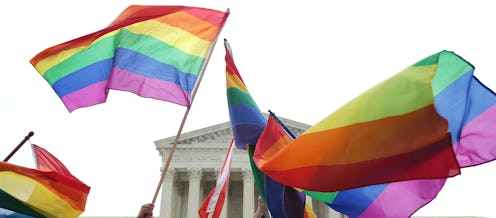News
SCOTUS Is Taking Up 3 LGBTQ Rights Cases & They're Way More Consequential Than You Think

In this op-ed, political scientist and Tufts University lecturer Miranda Yaver addresses what the Supreme Court sex discrimination cases could mean for the LGBTQ community.
The LGBTQ community has seen the Trump administration actively work to diminish their rights. The Supreme Court announced Monday that it would decide whether protections against sex discrimination extend to people based on sexual orientation and gender identity. The three cases that the justices have agreed to hear involve sex discrimination against LGBTQ employees, but the outcome of those cases could have serious ripple effects not just in the workplace, but in education and business settings as well.
Among the cases that the Supreme Court will hear is a New York case in which a court of appeals decided that firing an employee for being gay constituted sex discrimination. The court majority argued that to determine someone’s sexual orientation, one must consider the individual’s sex and the sex to whom they are attracted, and therefore the case fell within the scope of sex discrimination. An additional case that the Supreme Court will hear involves the firing of a Michigan employee after she announced that she was a transgender woman. A circuit court declared that was sex discrimination, too.
Sex discrimination is prohibited under the Civil Rights Act of 1964. Specifically, Title VII of the Act prohibits employment discrimination on the basis of sex, though the application of that rule has not always been consistent. While 4.5% of Americans — approximately 11 million people — identify as lesbian, gay, bisexual, or transgender, no national law explicitly prohibits employment discrimination based on sexual orientation or gender identity. And with lower courts disagreeing on the scope of LGBTQ protections, there has been ongoing uncertainty around LGBTQ employees’ rights.
It’s unclear just what federal protections the LGBTQ community has.
That’s why, even though same-sex marriage was declared a constitutional right four years ago, same-sex couples can be lawfully married over the weekend and then fired on Monday for being gay. The Equal Employment Opportunity Commission, a bipartisan, independent commission tasked with enforcing nondiscrimination laws, has interpreted the Civil Rights Act as protecting LGBTQ employees from sex discrimination. However, the Trump administration has said the opposite, leaving many workers vulnerable to being fired or subject to other discriminatory practices.
With the Supreme Court set to rule on the scope of sex discrimination as applied to sexual orientation and gender identity, it’s important to note that whatever they decide will set a precedent for other government guidelines. That would undoubtedly produce policy consequences that would affect gender equality in federally-funded programs like the Affordable Care Act, public housing, and education.
Education is one area in which the Trump administration has worked to scale back protections for LGBTQ students despite their particular vulnerability to sexual violence, bullying, and attempted suicide. Trump’s Education Department reinterpreted Title IX of the Education Amendments to exclude transgender students from prohibitions against sex discrimination in education settings and dismiss their complaints.
In October 2018, the Department of Health and Human Services argued that federal agencies should adopt a narrow definition of gender as being biologically based: defined as either male or female, unchangeable, and determined by the genitals with which one was born. This definition would effectively write the 1.4 million transgender Americans out of existence, making it all the more difficult for them to challenge discrimination based on gender identity in employment, education, and beyond.
With the scope of sex discrimination not yet clearly defined by the judiciary or the current administration, it’s unclear just what federal protections the LGBTQ community has. The Supreme Court could shape those protections considerably, and whatever it decides will likely set the stage for further lawsuits to clarify the scope of LGBTQ rights in other areas that prohibit sex discrimination. Businesses are also likely to seek religious or moral exemptions from adhering to whatever LGBTQ protections the Court may establish.
Notably, the Court that will issue these decisions no longer has a key voice on LGBTQ rights. The outcome of these cases might have been less concerning earlier on in the Trump presidency when Anthony Kennedy, the “median” justice who often voted in support of LGBTQ rights, was still on the Court. Kennedy was replaced with Brett Kavanaugh, a justice far to his right, and the new median justice is Chief Justice John Roberts, who dissented in prominent LGBTQ rights cases like Obergefell v. Hodges.
Considering the wide-ranging consequences of these cases — and with no true “median” at the center of the court — advocates of LGBTQ rights have ample reason for concern.